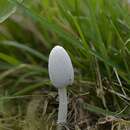fr
noms dans le fil d’Ariane


Guidance for identification
Der Schneeweiße Mist-Tintling oder kurz Schneeweiße Tintling (Coprinopsis nivea, Syn.: Coprinus niveus), auch Dung-Tintling genannt, ist eine ungenießbare Pilzart aus der Familie der Mürblingsverwandten (Psathyrellaceae).
Der Hut erreicht eine Breite von 1,5–4 cm und eine Höhe von 3–4 cm. Ganz junge Exemplaren sind zunächst eiförmig geschlossen und schirmen dann auf. Die kalkweiße Oberfläche ist dicht mit mehlig-kleiigen, ablösbaren Flocken bedeckt. Mit zunehmendem Alter reißt der Hut ein, franst aus und rollt sich auf. Die Lamellen sind anfangs weiß, dann grau und zuletzt schwarz. Der zylindrische Stiel ist weißlich und wird bis zu 12 cm hoch und 2–6 mm breit. Er ist hohl, zerbrechlich und ist feinflockig belegt. Das Fleisch (Trama) ist grau, sehr dünn und ohne markanten Geruch.
Die Sporen sind schwarz, elliptisch bis mandelförmig und messen 15–19 × 8,5–11 × 11–14 µm groß.
Jung ähnelt er der Hasenpfote (Coprinopsis lagopus). Diese wächst jedoch nicht auf Dung.
Der Schneeweiße Mist-Tintling ist ein seltener Pilz, der auf oder bei relativ frischem Dung, insbesondere Kuhfladen und Pferdeäpfeln, wächst.
Die Fruchtkörper sind von Juli bis Dezember zu finden.
Der Schneeweiße Mist-Tintling oder kurz Schneeweiße Tintling (Coprinopsis nivea, Syn.: Coprinus niveus), auch Dung-Tintling genannt, ist eine ungenießbare Pilzart aus der Familie der Mürblingsverwandten (Psathyrellaceae).
Coprinopsis nivea is a species of mushroom producing fungus in the family Psathyrellaceae.[1][2] It is commonly known as the snowy inkcap.
It was first described in 1801 by the German mycologist Christiaan Hendrik Persoon who classified it as Agaricus niveus.[3]
In 1838 it was reclassified as Coprinus niveus by the Swedish mycologist Elias Magnus Fries.[4][5]
In 2001 phylogentic analysis restructured the Coprinus genus and it was reclassified as Coprinopsis nivea by the mycologists Scott Alan Redhead, Rytas J. Vilgalys & Jean-Marc Moncalvo.[6]
Coprinopsis nivea is a small inkcap mushroom which grows in wetland environments.
Cap: 1.5–3 cm. Starts egg shaped expanding to become campanulate (bell shaped). Covered in white powdery fragments of the veil when young. Gills: Start white before turning grey and ultimately black and deliquescing (dissolving into an ink-like black substance). Crowded and adnate or free. Stem: 3–9 cm long and 4-7mm in diameter. White with a very slightly bulbous base which may present with white tufts similar to that of the cap. Spore print: Black. Spores: Flattened ellipsoid and smooth with a germ pore. 15-19 x 8.5-10.5 μm. Taste: Indistinct. Smell: Indistinct.[7][8]
The specific epithet nivea (originally niveus) is Latin for snowy or snow covered.[9] This is a reference to the powdery white appearance of this mushroom.
Grows in small trooping or tufting groups on old dung, especially that of cows[10] and horses, Summer through late Autumn. Widespread and recorded quite regularly.[7]
Coprinopsis nivea is a species of mushroom producing fungus in the family Psathyrellaceae. It is commonly known as the snowy inkcap.
Valkomustesieni (Coprinopsis nivea syn. Coprinus niveus) on munamainen tai kellomainen lopulta laakea mustesienilaji. Sienen lakki on valkoinen. Heltat ovat aluksi vaaleat ja mustuvat vanhemmiten. Jalka on valkonukkainen. Sieni kasvaa harvinaisena lannalla. [2]
Valkomustesieni (Coprinopsis nivea syn. Coprinus niveus) on munamainen tai kellomainen lopulta laakea mustesienilaji. Sienen lakki on valkoinen. Heltat ovat aluksi vaaleat ja mustuvat vanhemmiten. Jalka on valkonukkainen. Sieni kasvaa harvinaisena lannalla.
Coprinus niveus (Pers.) Fr., Epicrisis Systematis Mycologici (Upsaliae): 247 (1838).
1,5-4,5 x 2–3 cm, prima cilindrico-ovoidale, poi conico-campanulato, infine appianato.
Larghe, adnate, bianche negli esemplari giovani, poi grigie e infine nere, deliquescenti, con il filo bianco e fioccoso
6–9 cm, cilindrico, cavo, attenuato all'apice, ingrossato alla base, fioccoso, di color bianco.
Sottile, fragile, membranacea, bianco-grigiastra.
Senza valore per via dell'esiguità della carne, anche se probabilmente innocuo.
Specie fimicola, cresce in prati e pascoli alpini su escrementi animali.
Capel fin a 3 cm, bianch, da fiocos a farinos. Bòrd strià. Lamele grise peui nèire. Gamba àuta fin a 8 cm e larga fin a 0,5 cm, farinosa-fiocosa.
A chërs ëdzora a le buse.
![]() A venta mai mangé un bolè trovà se un a l'é nen un bon conossidor dij bolè!
A venta mai mangé un bolè trovà se un a l'é nen un bon conossidor dij bolè!
Sensa anteresse alimentar.
Coprinus niveus (Pers. : Fr.) Fries
Capel fin a 3 cm, bianch, da fiocos a farinos. Bòrd strià. Lamele grise peui nèire. Gamba àuta fin a 8 cm e larga fin a 0,5 cm, farinosa-fiocosa.
AmbientA chërs ëdzora a le buse.
Comestibilità![]() A venta mai mangé un bolè trovà se un a l'é nen un bon conossidor dij bolè!
A venta mai mangé un bolè trovà se un a l'é nen un bon conossidor dij bolè!
Sensa anteresse alimentar.
Coprinopsis nivea (Pers.) Redhead, Vilgalys & Moncalvo 2001
СинонимыНаво́зник белосне́жный (лат. Coprinopsis nivea) — гриб семейства Псатирелловые (Psathyrellaceae). Несъедобен.
Шляпка размером 1—3 см, сначала удлинённо-яйцевидная, затем становится колокольчатой или конической, до почти плоской с отогнутыми вверх краями. Кожица чисто-белая, покрыта обильным мучнистым налётом (остаток покрывала), который смывается дождём.
Мякоть шляпки светлая, очень тонкая.
Ножка 5—8 см длиной и 1—3 мм в диаметре, белая, с мучнистой поверхностью, вздутая в основании.
Пластинки свободные, частые, сначала серые, затем чернеют и разжижаются.
Споровый порошок чёрный, споры 15×10,5×8 мкм, уплощённо-эллипсоидальные, слегка шестиугольной формы, гладкие, с порами.
Сапротроф, растёт на конском навозе или рядом среди влажной травы. Распространён в Европе.
Сезон лето — осень.
Наво́зник белосне́жный (лат. Coprinopsis nivea) — гриб семейства Псатирелловые (Psathyrellaceae). Несъедобен.
Agaricus niveus Pers. 1801 basionym Coprinus niveus (Pers.) Fr. 1838